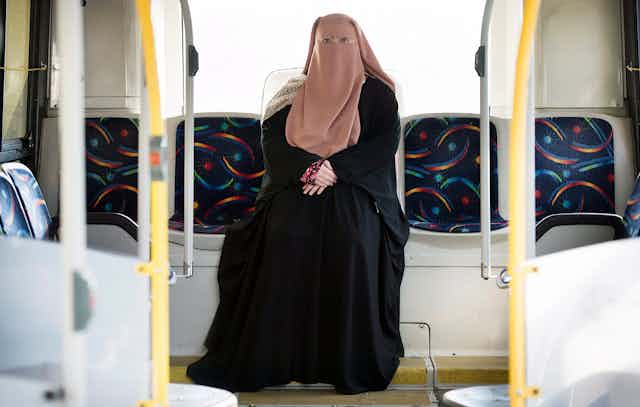“I should see your face and you should see mine.” - Premier Philippe Couillard on the passing of Bill 62 in Quebec.
The recent passage of Bill 62 — banning the wearing of the niqab in Quebec for those seeking access to public services, including taking public transit — raises an important question about why such a draconian move was considered necessary for such a tiny portion of the population.
Only a minority of a minority chooses to cover their faces, as Global News radio host Supriya Dwivedi pointed out in her recent commentary. Only 114,000 people identify as Muslim women in Quebec, of which an even smaller minority wear the hijab (which covers the head and neck), and only a fraction of them wear the niqab (which covers the head and face). That represents perhaps as little as 0.7 per cent of the entire population, or about 90 women.
While there has been considerable condemnation of this bill, both in Quebec and the rest of Canada, this issue needs to be contextualized within the larger perspective of how women’s bodies are used. To be sure, the insistence on visibility has been legitimized by the War on Terror — the U.S.-led military campaign following the terrorist attacks of Sept. 11, 2001 — where surveillance became the new normal and everything had to be open for scrutiny.
As a communications scholar, I have explored representations of Muslim women over the last decade, both in the context of war and femicide (the murders of women because they are women). This knowledge propels me to challenge and interrogate Premier Philippe Couillard’s insistent need to see someone’s face.

Data mining and commodification of women’s bodies
Technologies like the telephone, before its new incarnation as the smart phone with video-calling apps, have long been used to talk to others without seeing their faces.
But data mining relies on visibility. Every time we agree to use an app, we input our details and make aspects of our lives known. This information is used to create products that suit our tastes. Like audiences of television shows, we are sold to advertisers who then promote products designed to cash in on our attention - our mind share.
Women’s bodies are used in similar ways. They are data-mined to extract information from them that is then used to target-market them — while also making them complicit in the act of fitting into the normative standards of beauty. As feminists have long pointed out, visibility is also tied to the sexual commodification of women. To make bodies visible is to make them accessible.

Like companies that mine data to subsequently monetize and capitalize on consumers, the government uses women’s bodies as a commodity to work for its own messages. The slender, sexually available and beautiful young woman then works as a symbol of an open, sexually liberated society.
Sanctioning such norms, the Quebec government portrays itself as righteously secular, although it operates literally under a Christian cross, thereby appeasing the political demands of the ultra-right, a growing segment in the province.
The government knows full well that its legislation is going to be challenged, but they are sending a clear message to their constituents. Bill 62 also “outlaws” sunglasses and balaclavas — a strategic camouflage to conceal the law’s true intent.
The Quebec government doesn’t just want to deter Muslims from settling in the province, they are actually using Muslim women’s bodies as a political ploy. The insistence of visibility conveys the message that to belong to Quebec, Muslim women must toe the line; they must dress, talk and behave in particular ways.
Symbolism of women’s bodies
Yet another aspect of visibility is its symbolic value. A potent example is how women’s bodies are used in times of war. Enemy forces often capture women, use and abuse them, and then either murder or abandon them. All of this has propaganda value. And it has to be effectively carried out if it’s to have the desired outcome.
This serves a threefold function for the enemy: First, it provides the rank and file with access to the “spoils of war” — where women are the spoils. Second, it allows the enemy to destroy the reproductive capacities of those they are warring with either by killing women or by impregnating women, thus making them carriers of the enemy’s offspring. Without women, a nation cannot reproduce itself.
Third, women are often the symbolic boundaries of the nation, socializing and educating the next generation. Take away the women, and you destroy the nation in terms of its social reproduction over time. Witness the history of Indigenous women and one can quickly get a sense of how this works.
Couillard and Bill 62: An assertion of Quebec sovereignty
As a state targets the women of a community, they also target and impact their families and the men in their families. Bill 62 follows a long trajectory of abuses against Muslim women, not to mention the rising tide of Islamophobia within both daily life and in national affairs.
Muslim women have become the battleground for the reassertion of Quebec’s sovereignty in the endless federal-provincial melée. Visibility works as a way of ensuring compliance — those who want to remain within the nation know how not to dress, talk and behave.
Conversely, it allows the state to demonstrate that it is responding to a majority. The irony of all of this is that the Taliban, under the guise of Islam, imposed restrictions that forced women to dress in particular ways, whereas now, this secular state forces women to unveil themselves.



